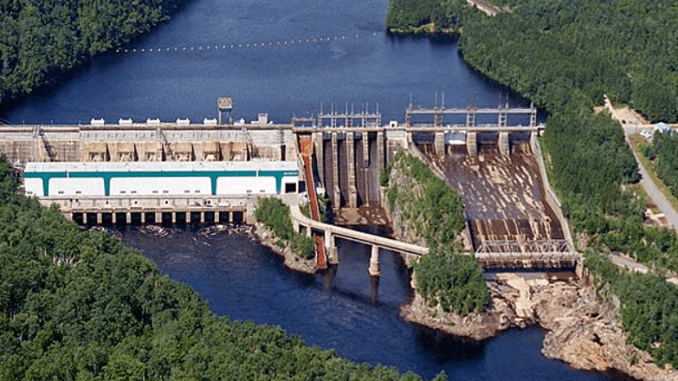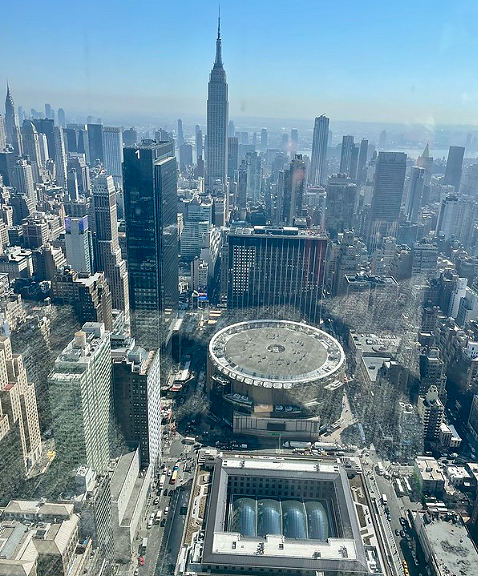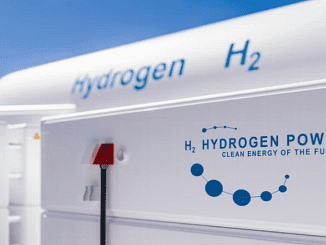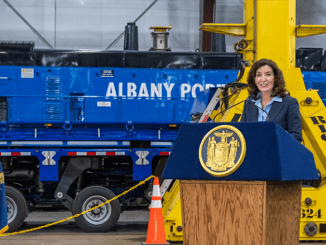
ALBANY, New York, April 19, 2022 (ENS) – To deliver clean, renewable solar, wind and hydroelectric power from upstate New York and Canada south to fossil-fuel powered New York City, the State Public Service Commission has approved contracts with Clean Path New York LLC for its Clean Path NY project and H.Q. Energy Services Inc. for its Champlain Hudson Power Express project.
As the largest electricity transmission projects contracted for New York State in the last 50 years, these two projects will cut the city’s reliance on fossil fuel-fired generation by more than 50 percent in 2030.
The two new transmission lines will be built underground to avoid, minimize, and mitigate environmental damages, including impacts on sensitive species and habitats, and also to be resilient in the event of extreme weather.
Both projects are required to go through the PSC’s Article VII permitting process, which includes a full review of the need for the project and any environmental impacts of the siting, design, construction, and operation of the transmission facilities. The Champlain Hudson Power Express, CHPE, has received its Article VII permit, and Clean Path NY will begin the process.
The actual delivery of the renewable energy to New York City is expected to begin in 2025 for the fully permitted CHPE project and in 2027 for the CPNY project.
Governor Kathy Hochul made the announcement Friday in Albany in celebration of Earth Week, which this year runs from April 18 to Earth Day on April 22. From the first Earth Day in 1970, April 22 has been celebrated with events worldwide in support of the environment and to raise awareness for the environmental protection and care of the planet.
“New York continues to lead the nation with innovative green energy initiatives and has been an example to the rest of the world how to confront the perils of climate change, the existential threat of our time,” Governor Hochul said.
“Today’s decision is a major step forward in achieving New York State’s goal of 70 percent of our energy from renewable resources, while paving the way for thousands of high-quality jobs, spurring billions in economic activity, reducing our dependence on fossil fuels, and ushering in a cleaner, greener New York for all,” the governor said.

The selected projects are expected to deliver 18 million megawatt-hours of clean energy a year, or more than a third of New York City’s annual electric consumption, from a diverse and resilient clean generation portfolio including onshore wind, solar, and hydroelectric power, backed by energy storage, from upstate New York and Quebec.
Combining these projects with the existing contracted portfolio of offshore wind projects connecting directly into New York City, turns the page on the city’s energy history, increasing resilience and reliability while improving air quality.
The state’s first-of-its-kind renewable energy and transmission projects are expected to deliver up to $5.8 billion in overall societal benefits statewide, including greenhouse gas reductions and air quality improvements.
The transmission projects are projected to stimulate about $8.2 billion in economic development across the state, including investments in disadvantaged communities. When built, these projects will help protect against volatile fossil fuel price fluctuations and stabilize long-term energy costs.
“Today’s historic decision by the Public Service Commission is a game-changer for New York’s transition away from fossil fuels and helps to ensure New York City, the nation’s most populated city, will be powered with clean and reliable renewable energy,” Doreen Harris, president and CEO, New York State Energy Research and Development Authority, NYSERDA, said.
“These transformational projects pave the way for cleaner air and a healthier future for all New Yorkers, especially in communities disproportionately burdened by air pollution, and will stimulate our statewide economy with an investment of $8.2 billion in economic development and create thousands of high-quality jobs,” Harris said. “We look forward to working with our partners at Clean Path NY and Hydro Quebec to deliver these critical benefits for families and businesses across the state.”
Indigenous Communities Will Contribute Wind Power
HydroQuebec, one of the world’s largest hydroelectricity producers, operates 60 hydroelectric generating stations. Close to 100 percent of the public utility’s electricity is generated using water, a generating option with very low greenhouse gas emissions and no toxic waste.
“We are both humbled and proud to see this formidable partnership between Quebec and New York move forward,” said Sophie Brochu, president and CEO Hydro-Québec. “This project is a model for an equitable energy transition and an eloquent example of how we can work together to decarbonize the Northeast.”
Indigenous Canadians will have an important part to play in bringing renewable energy to New York City.
As a component of these landmark deals, Hydro-Quebec will purchase electricity from the planned Apuiat wind farm, developed by the Innu communities in Quebec, as well as enter into a partnership with the Mohawk Council of Kahnawà:ke for joint ownership of the line in Québec that will connect to the Champlain Hudson Power Express.
“The Champlain Hudson Power express is a game changer,” said Mohawk Council Grand Chief Kahsennenhawe Sky-Deer. “We will continue our responsibility as stewards of the environment to always protect our Mother Earth, especially from the dangers of climate change and global warming. But we are also ensuring Indigeneous peoples have a seat at the table as business partners, and have a voice in the overall economy moving forward.”
New York City is Ripe for Clean Energy
Clean Path NY leaders Michael Polsky of Invenergy, Jeff Blau of energyRe, and Justin Driscoll of the New York Power Authority are pleased that clean energy progress is finally underway.
“Clean Path NY is a turning point for New York as we work to finally resolve the congestion that has plagued our electricity grid for decades and slowed progress on urgent climate goals. The Clean Path NY project will deliver good-paying jobs, make our air cleaner, and provide reliable emissions-free power to residents and businesses across the state – a win-win-win for New York,” the three men said. “We are proud to help make New York a healthier, more resilient place to call home.”
The City of New York has confirmed that it will purchase a portion of the renewable attributes generated by the two projects, helping to make the scale of these projects possible while creating the opportunity to reduce the cost of these projects by up to $1.7 billion to all other ratepayers.
New York City Mayor Eric Adams said, “This is a historic milestone in our mobilization against climate change and fight for environmental justice. Today, we begin dismantling the disparate access to renewable energy that has plagued our city for far too long, especially those communities that reside in the shadow of some of the oldest, most polluting power plants in the state.”
“Not one but two new transmission lines will be built to bring clean renewable energy from the north into New York City – a feat that has not occurred at this scale in decades. I’m proud of the city’s commitment to purchase 100 percent of its electrical need from these lines, catalyzing others to do the same. I want to applaud the commission, NYSERDA, and Governor Hochul for taking this bold action and I look forward to continued partnership with the governor to tackle climate change,” Mayor Adams said.
The NYS Office of General Services has committed to entering into a contract with the New York State Energy Research and Development Authority, NYSERDA, for Tier 4 Renewable Energy Certificates, RECs, associated with the energy used by state agencies and departments located in New York City.
NYSERDA will also offer renewable attributes from these projects for voluntary purchase. This will finally enable the many New York City organizations with interest in switching to clean energy, but who have been unable to do so on-site due to practical constraints, to go 100 percent renewable with confidence.
With approval of the contracts, NYSERDA payments will begin for each respective project once the project has obtained all required permits and approvals, has completed construction, and is delivering power to New York City.
In July 2019, New York State passed the Climate Leadership and Community Protection Act requiring the state to meet 70 percent of its electricity needs with renewables by 2030 and 100 percent with zero-carbon sources by 2040, and to cut greenhouse gasses economy-wide 85 percent by 2050.
Featured image: HydroQuebec’s Beaumont dam on the Saint-Maurice River in central Quebec, which flows south into the Saint Lawrence River at Trois-Rivières, Quebec. (Photo courtesy HydroQuebec)



